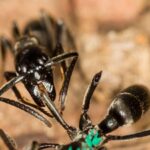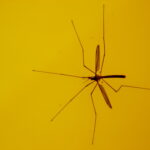Caught in the Light: Flying Insects
Flying insects seem magnetized by light, but why? New research uncovers the dorsal-light-response mechanism behind this phenomenon.
By William Harley
In the dark of night, flying bugs can be seen dancing around lights. They erratically swarm and occasionally nosedive to their demise, seemingly driven by a love for the warm glow. It might appear obvious that bugs are simply fascinated with light, but this is not the case. The meaning behind their dance is less romantic. It is, however, more graceful than the chaos we think we see.
There are multiple popular theories as to why flying bugs gather around light. Maybe they fly to the light for safety. They could be mistaking it for the moon during navigation. Maybe they are attracted to the warmth. They could also be blinded by the glow. Researchers from Imperial College London and Florida International University have identified the real reason that bugs gather around lights: The flying insects are actually trapped there in an effort to stay the right way up during flight.
A struggle to stay upright
Creatures that are blessed with the ability to fly are simultaneously cursed with the challenge of coordinating themselves in the air. They fight the pull of gravity and the disorientation of a world moving in all directions. Larger flying animals can rely on gliding, but smaller animals require a different tool to maintain altitude and react to turbulence. This tool is the dorsal-light-response.
RELATED: Bee Behavior Affected by Pesticides and Temperature
The dorsal-light-response is a behavior where flying insects keep their top side—the dorsal side—pointed at the brightest area in their vision. This response developed through years of evolution because, regardless of night or day, the sky is a strong signal of which way is up. With the dorsal-light-response and a strong glow in the sky, bugs are able to stay upright. Flicking on a light bulb, however, throws this response into disarray, confusing the insects’ flight and catching them in the glow.
This research team has poked holes in each of the popular theories as to why flying bugs circle artificial lights. The study highlighted that insects rarely flew directly toward the light source, suggesting that it is not seen as an escape to safety. Insects can also fly with the light on either side of their body, discrediting that they mistake it as the moon for navigation. For this experiment, the researchers used LED lighting that emitted negligible amounts of heat, proving that the insects were not attracted to warmth. Lastly, the flights were predictable, suggesting that it is unlikely the insects were blinded by the lights.
Flying insects trapped in flight patterns
Now we understand why flying bugs gather at artificial light sources, but there is a gracefulness that underlies what appears to be an erratic dance.
The researchers discovered this dance in the wild using high-speed cameras and light bulbs. Even with artificial lights to trap the insects, tracking the flying dancers against the night sky is challenging. So, researchers illuminated the area with infrared light—a light that neither insects or humans can see but is easily captured by the cameras.
RELATED: A Fly Cruises the Smell Arena for Science
Three flight patterns materialized from the footage. The first is “orbiting”: a circular flight around the bulb with the body slightly tilted to the light. The second is “stalling”: a sharp climb away from the ground as the insect faces away from the light source. The third is “inversion”: a dive to the ground as the insect flies over the light. All of these moves appeared to be influenced by the dorsal-light-response, with the insects keeping their back toward the light—even if it ended in collision.
Digging deeper
In order to determine if this really was a dorsal-light-response, the bugs had to be observed in more detail and in a confined space. The stage for this study: a cylindrical tent around a single bulb with eight cameras. With this suite of cameras recording in infrared and miniscule markers physically stuck to the insects to serve as mirrors for infrared light, the position and orientation of the individual bug could be determined.
Images captured of four different species with this setup indicate that insects did strongly tilt their backs to the light. This orientation greatly differed from the control data of the same insects flying in normal light conditions—bright and diffuse—instead of the concentrated light source. They also demonstrated the three flight patterns observed from flights around artificial light in the wild. The flying insects did demonstrate the dorsal-light-response.
To check if natural light could free the insects from their dance, the research shrouded the light source to mimic the dispersed light of the sky through a forest canopy. This did free the insects, and they resumed a normal flight pattern.
RELATED: New in Rainforest Conservation: Seeing the Forest and the Trees
Don’t follow the light
Some insects in the study entirely avoided entrapment by the lights. Hawkmoths that were foraging resisted the glow, suggesting that there is a mechanism to suppress the dorsal-light-response. Other senses may allow flying insects to maintain orientation in flight when the dorsal-light-response is disrupted. For example, the pull of gravity on appendages such as legs could indicate direction. Unfortunately for the bug, the gravity-sensing ability is derailed when turning or accelerating.
The dorsal-light-response also fails to explain how bugs avoid tilting to the stars and moon in the night sky or manage flying when the top of the sky is not the brightest. This necessitates further research into how flying insects account for a range of brightness and how they are impacted by the distance to a light source. One experiment done previously tracked moths released 85 meters from a light source only to find that 2 of the 50 moths ended up at the light.
Most of the bugs unlucky enough to fly near an artificial light, however, are doomed to be trapped in a dance dictated by their own inner workings.
This study was published in the peer-reviewed journal Nature Communications.
Reference
Fabian, S. T., Sondhi, Y., Allen, P. E., Theobald, J. C., & Lin, H.-T. (2024). Why flying insects gather at artificial light. Nature Communications, 15(1), 689. https://doi.org/10.1038/s41467-024-44785-3


About the Author
William Harley completed degrees in biochemistry & molecular biology and in chemical engineering from Oregon State University. While an engineer by profession, he enjoys creating music, trail running, and baking. Connect with William on LinkedIn.




